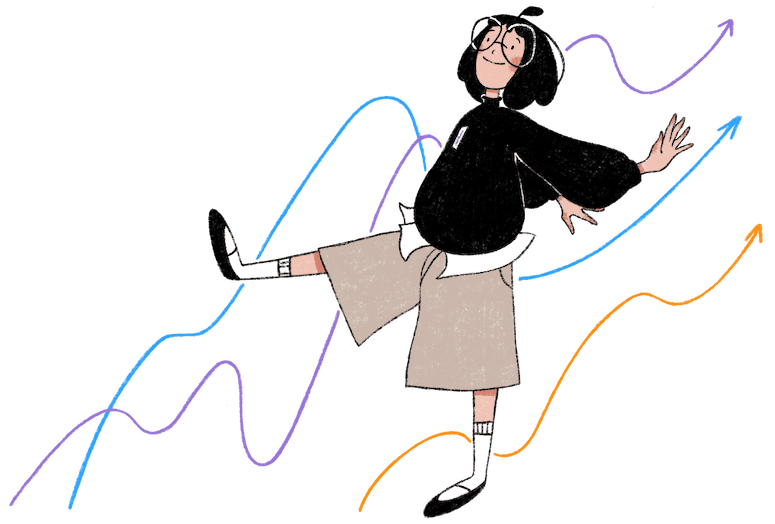Top 10 Landing Page Metrics to Track
8 min read
Whether youre selling software, physical products, or offering a service, your landing page is the first real impression people get. It’s not just a webpage. It's the digital moment where someone decides if your offer is worth their time.
And the truth is, you don’t get long to convince them.
A few seconds, maybe. That’s all it takes for a visitor to decide whether to scroll down, click through, or bounce off.
That’s why your landing page ends up doing most of the heavy lifting.
It pitches. It persuades. It either converts or loses the user altogether.
So if you care about growth, signups, demos, sales, whatever your conversion goal is, then your landing page has to work like a well-oiled machine.
But you can’t improve what you don’t measure.
And not just any data. You need the right data; the kind that tells you what’s working, what’s failing, and where your page is leaking potential conversions.
In this post, we’re breaking down the most important landing page metrics to track.

These metrics will help you understand performance clearly and make smarter decisions to get more from the traffic you're already getting.
1. Conversion Rate
This is the one metric that tells you if your landing page is doing its job.
Conversion rate measures the percentage of visitors who take a specific action on your page. That could be signing up, making a purchase, booking a demo, or filling out a form.
A high conversion rate means your message is landing. Your value proposition is clear. Your CTA is working.
But if the number is low, something’s off. Maybe your headline isn’t strong enough. Maybe the offer isn’t compelling. Or maybe the page feels too slow or confusing.

Tracking your conversion rate helps you focus your optimization efforts. If a small tweak, like changing button text or reordering sections, leads to a better conversion rate, then it’s a win you can repeat across other pages.
The point is: conversions are the goal. Every other metric helps you understand why people convert, or why they don’t.
2. Click-Through Rate (CTR)
Click-through rate shows you how many people are engaging with your page elements, usually your primary call-to-action.
It’s not the same as conversion rate. CTR tells you whether people are interested enough to take that first step. Like clicking a “Get Started” button, a product image, or a link to the next page in your funnel.
A low CTR often means the page isn't generating enough curiosity or clarity. Maybe your CTA isn’t visible enough. Maybe it’s not persuasive. Maybe it just doesn’t feel like the obvious next step.
By tracking CTR, you’re watching how people interact with your content.
If your traffic is solid but your click-through rate is poor, then it’s time to rethink your layout, messaging, or even your CTA placement. Sometimes, it’s as simple as making the button bigger or changing the wording to match user intent.
CTR is where your landing page starts turning attention into action. It's an early sign of interest and a key place to optimize.
3. Bounce Rate
Bounce rate measures the percentage of visitors who land on your page and leave without clicking anything else.
No scroll. No click. No action. Just in and out.
It’s not always a bad sign. Sometimes people get what they need quickly. But in most cases, a high bounce rate means your page isn’t pulling people in.
Maybe the content doesn’t match their expectations. Maybe it loads too slowly. Or maybe it just doesn’t look trustworthy or relevant at first glance.
Those first few seconds matter.
Tracking bounce rate helps you catch when something’s broken visually, technically, or contextually. If a landing page has a significantly higher bounce rate than others, that’s a flag worth investigating.
Lowering your bounce rate often comes down to clarity, speed, and alignment. Make sure your landing page speaks directly to the audience it’s attracting and fast.
4. Average Time on Page
This tells you how long visitors are sticking around.
It’s a good signal of engagement. If people are spending time on your landing page, there’s a chance they’re reading your copy, exploring your offer, and considering next steps.
But if the time is too short, it usually means they’re not connecting with the content, or they’re confused, overwhelmed, or simply uninterested.
Average time on page helps you gauge content quality and pacing.
If you just launched a new headline, video, or feature section, this metric can show you whether people are actually paying attention to it. If time increases after a change, that’s a promising sign.
Pair this with scroll depth or click maps, and you’ll get a fuller picture of what parts of your page are working and what’s getting ignored.
Time alone doesn’t equal conversions. But without time, there’s no chance for conversion at all.
5. Cost per Conversion
This is where performance meets profitability.
Cost per conversion tells you how much you're spending, usually in ad dollars, to get a single conversion from your landing page. Whether that's a lead, a signup, or a sale, it’s the price you’re paying for results.
It’s a crucial metric if you're running paid campaigns for your landing page.
A beautiful landing page that doesn’t convert efficiently can drain your budget fast. If your cost per conversion is high, you're either targeting the wrong traffic, offering the wrong thing, or your page just isn't doing enough to convince.
The goal isn’t just to get conversions, it’s to get them affordably.
Here’s a quick example: If you spend $200 on ads and get 10 conversions, Your cost per conversion is $200 ÷ 10 = $20.
Now, is $20 per conversion good? It depends on the value of what you’re selling.
If your product costs $100 and you make $60 profit per sale, then paying $20 to acquire a customer makes sense. You’re still in the green. But if you’re selling a $15 item with thin margins, $20 per conversion is clearly unsustainable.
Tracking this metric helps you find the balance between cost and value.
If two landing pages convert equally well but one does it at half the cost, that’s the one you scale.
And if your cost is creeping up over time, this is your early warning to pause, investigate, and optimize.
6. Exit Rate
Exit rate tells you the percentage of people who leave your site from a specific page.
It’s different from bounce rate. Bounce rate is about people who visit only one page. Exit rate looks at people who may have viewed other pages, but chose to leave after this one.
For landing pages, a high exit rate can be a red flag.
If most users are dropping off from your landing page without taking action, it usually means something’s off. Maybe the offer isn’t clear. Maybe the next step isn’t obvious. Or maybe there’s friction. Too much info, too many options, not enough urgency…
But context matters.
Sometimes, an exit is expected, like on a “Thank You” page after a form submission. But if your main landing page is bleeding traffic, it’s worth a closer look.
Use exit rate to identify where your funnel is losing people.
If your visitors are exiting before converting, try simplifying the page, tightening the message, or testing a stronger call-to-action.
Every exit is a potential lost opportunity. This metric helps you plug the leaks.
Start tracking your landing page metrics.
Sign up for Seline now - no credit card required. Cookieless, privacy-friendly, independent.
Get started
7. New vs Returning Visitors
This metric shows the balance between people discovering your landing page for the first time and those coming back for another look.
New visitors are important. They show that your marketing, SEO, or ads are bringing in fresh eyes.
But returning visitors are often more valuable.
A return visit usually signals interest. It means the person didn’t convert the first time but saw enough value to come back. That’s momentum, and it’s often one step away from a conversion.
Tracking this ratio helps you understand audience behavior.
If your page is getting tons of new visitors but very few return, you might not be leaving a strong enough impression. Maybe your offer isn’t memorable. Maybe there’s no reason for them to come back.
On the flip side, if you have a healthy flow of returning users, that’s a good sign your page is resonating, especially if those users eventually convert.
This metric also helps you measure the impact of retargeting campaigns or follow-up emails. If return visits go up after a remarketing push, you’ll know it’s working.
Bottom line: returning visitors are often closer to the finish line. Keep an eye on them.
8. Traffic Sources
Not all traffic is created equal.
Traffic sources tell you where your landing page visitors are coming from—search engines, social media, paid ads, email campaigns, referrals, and so on.
Each source brings in different types of users, with different levels of intent.
For example, traffic from search usually has higher intent. They are people who are actively looking for something. Ad traffic might come in quicker, but be less qualified if targeting is off. Social traffic might be casual, curious, or completely cold.
By tracking your traffic sources, you can figure out which channels drive performance, not just visits.
If paid search traffic converts better than Facebook ads, it makes sense to double down there. If email campaigns bring in returning users who eventually convert, then that's a channel to nurture.
This metric also helps you diagnose drops in performance. If your conversion rate dips and you notice most of your traffic is now coming from a lower-quality source, that gives you direction on what to fix.
In short: knowing where people come from helps you control where they go next, and what to expect when they land.
9. Scroll Depth
Scroll depth tells you how far down the page users actually go.
It’s a simple but powerful metric, especially for landing pages with longer copy, feature sections, testimonials, or multiple CTAs.
If most users are dropping off before they reach your main call-to-action, that’s a problem. It could mean your top section isn’t engaging enough, or your page feels too long, cluttered, or confusing.
This metric helps you spot where interest fades.
Let’s say only 30% of visitors scroll past the halfway mark. At that point, everything below might as well not exist. Maybe you need to bring your value proposition higher. Maybe the copy needs tightening. Or maybe you just need to cut some fluff.
You can also test how different layouts affect scroll behavior. A clean design with a clear visual hierarchy usually encourages deeper scrolling.
Scroll depth doesn’t tell you why users stop, but it tells you where they do and that’s a good place to start improving.
10. Engagement Events
Engagement events track what users do on your landing page beyond just scrolling or clicking the main CTA.
These include things like:
-
Clicking tabs or dropdowns
-
Watching a video
-
Expanding FAQ sections
-
Hovering over product images
-
Clicking to view pricing
These small interactions might not be conversions, but they’re signals. They show interest, curiosity, and involvement with your content.
If users are clicking through your product tabs or watching your intro video to the end, that’s engagement. It means your content is resonating—even if they don’t convert on the spot.
Tracking engagement helps you understand which parts of your landing page are pulling people in, and which parts are being ignored.
For example, if nobody plays your video or clicks to view more details, it could mean your media isn't strong enough or the placement is wrong.
And when engagement is high but conversions are low, it’s a sign that users are interested but unsure. That’s your cue to optimize messaging, trust elements, or the CTA itself.
The more users interact, the more likely they are to convert. Engagement events show you how close they’re getting.
Measure Your Landing Page Metrics with Seline
Knowing what to track is one thing. Knowing how to track it without getting overwhelmed is just as important.
Many analytics tools drown you in data you don’t need. Others are bloated, slow down your site, or rely heavily on cookies that break with modern privacy rules.
Seline is a simple, powerful, and privacy-friendly way to track all the landing page metrics that matter, without the fluff.
It runs lightweight in the background, doesn’t use invasive cookies, and still gives you the clarity you need: scroll depth, conversion rate, bounce rate, traffic sources, engagement, and more.
Whether you're optimizing a landing page for your SaaS product, online store, or newsletter signup, Seline gives you the insights that move the needle.
And because it’s built to be fast and focused, you get your data without sacrificing site speed or user trust.

